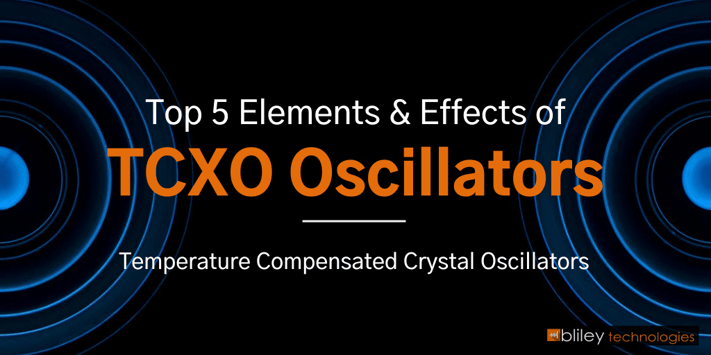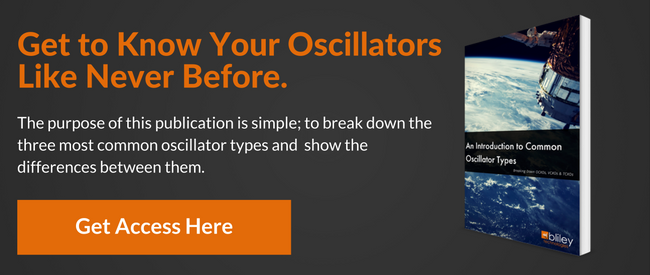
The most common types of crystal oscillators in electrical and RF engineering include OCXOs, TCXOs, VCXOs, and clock oscillators. In this post, we'll be reviewing the basics of temperature compensated crystal oscillators (TCXOs).
Introducing the Temperature Compensated Crystal Oscillator (TCXO)
The temperature compensated crystal oscillator (TCXO) is a form of crystal oscillator used when a precision frequency source is required within a small space and at a reasonable cost.
By applying temperature compensation within the quartz crystal oscillator module, it is possible to considerably improve on the basic performance of the crystal.
Because of their usefulness, a wide range of TCCXOs are available from many suppliers and in a variety of packages and mounts (surface, through-hole, etc.). Some TCXOs are compatible with the dual inline format used for many through-hole mounted integrated circuits.
Related: Crystal Oscillators: The Beginner's Guide (OCXO, TCXO, VCXO, & Clocks)
How To Minimize the Effects of Temperature on the Quartz Crystal
Although crystal oscillators are a highly stable form of oscillator, they are nevertheless affected by temperature. The type of crystal cut inside the oscillator can help to minimize the effects of temperature, but oscillators are still affected by temperature to some degree.
For a crystal cut known as the AT cut, the drift with temperature can be minimized around normal ambient temperature, but the rate of drift will rise above and below this point.
Related: Can a Crystal Oscillator Operate Outside of the Specified Temperature Range?
Typical Frequency/Temperature Curve for Quartz Crystal
The effects of temperature are, to a large degree, repeatable and definable. Therefore, it is possible to compensate for many of the effects using a TCXO.
A TCXO adjusts the frequency of the oscillator to compensate for the changes that will occur as a result of temperature changes. To achieve this, the main element within a TCXO is a voltage controlled crystal oscillator (VCXO). This is connected to a circuit that senses the temperature and applies a small correction voltage to the oscillator, as shown below.

5 Main Elements of the TCXO
There are 5 different elements that comprise the temperature compensated oscillator:
1. The Compensation Network
The compensation network is the key to the operation of the whole system. The curve for the temperature frequency response can be expressed approximately in the form of a 3rd order polynomial expression, although a more accurate representation takes into account some non-linearities and works out to be close to a 5th order polynomial. The compensation network needs to sense the temperature and produce a voltage that is the inverse of this.
Early designs would have used analog circuitry and often directly used a network of capacitors, resistors, and thermistors to directly control the frequency of oscillation. This type of circuit included both blocks on the diagram of the compensation network and the crystal frequency pulling block.
Compensating Voltage for TCXO Temperature Linearization
Currently technologies typically adopt an indirect approach where the temperature is sensed in the compensation network, and a voltage is generated that provides a frequency change that is the inverse of the temperature curve.
This can be achieved using analog components, but current technologies often incorporate some form of digital signal processing to be able to generate a far more accurate response, with the possibility of linearizing units separately by programming a ROM with the response of the particular oscillator. The DSP circuitry is often contained within a special ASIC to enable it to be tailored to suit the application without draining too much current.
2. The Oscillator Pulling Circuit
Once the voltage has been generated, this is applied to a circuit that can pull the frequency of the crystal oscillator. Typically, this incorporates a varactor diode and some low-pass filtering.
3. The Crystal Oscillator Circuit
The crystal oscillator circuit is normally a standard circuit, but one that is designed to give the operating conditions for the crystal with ideal drive levels, etc.
4. The Voltage Regulator
In order to prevent external voltage changes from introducing unwanted frequency shifts, the overall TCXO should incorporate a voltage regulator, which should not introduce unwanted temperature effects.
5. The Buffer Amplifier
A buffer amplifier is required to give the increased drive to the output. It should provide isolation to the crystal oscillator from any external load changes that may be seen.
TCXOs normally have an external adjustment to enable the frequency to be reset periodically. This enables the aging effects of the crystal to be removed. The period between calibration adjustments will depend upon the accuracy required, but may typically be six months or a year. Shorter periods may be used if very high levels of accuracy are required.
Related: Temperature Compensated Crystal Oscillators (TCXOs): Performance & Common Types
Bliley Takes You Further
Need a TCXO for your application but not sure where to start? Browse our full line of oscillators or reach out to our engineers with your questions.
Want to learn more about which type of crystal oscillator is best for your application's needs? Download our free eBook below to learn more about the common types of oscillators.






